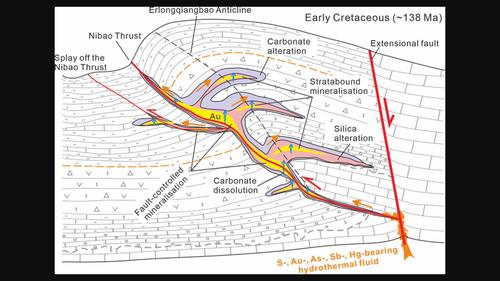右江盆地泥堡金矿方解石Sm - Nd等时年龄及Sr - Nd同位素
IF 0.8
4区 地球科学
Q3 GEOLOGY
引用次数: 1
摘要
中国西南部的右江盆地是仅次于美国内华达州的世界第二大类卡林金矿。然而,金矿成矿的年龄和热液成因仍存在争议,导致对金矿成矿的地球动力学背景和成因机制认识不清。泥堡金矿床是右江盆地北部一个层控、断裂控制的大型卡林型金矿床。成矿热液的演化可分为3个矿石阶段,主要表现为早期石英—多孔黄铁矿、主石英—方解石—磷灰石—绢云母—黄铁矿—毒砂—金、晚期石英—方解石—萤石—雄黄—辉锑矿组合。泥堡主矿期和晚矿期方解石脉富含中稀土元素,这是右江盆地低温热液金锑矿伴生热液方解石脉的显著特征,其Sm - Nd等时线年龄为138±1 Ma。绝大多数矿期方解石样品87Sr/86Sr比值较窄,εNd(t)值分别在0.708119 ~ 0.708423和- 1.1 ~ - 3.3之间,表明含金热液可能来源于地幔和地壳物质的混合作用。因此,我们认为右江盆地早白垩世的金成矿作用是由古太平洋地壳俯冲后的大规模岩石圈伸展引发的,热液流体可能来源于地幔,并经历了扬子上陆地壳的污染。本文章由计算机程序翻译,如有差异,请以英文原文为准。

Sm‐Nd isochron age and Sr‐Nd isotopes of the calcite from the Nibao gold deposit in the Youjiang Basin, SW China
The Youjiang Basin in SW China is the second‐largest Carlin‐like goldfield in the world after Nevada, USA. However, the age and the hydrothermal origin of the gold mineralization are still in controversy, which leads to ambiguities in understanding the geodynamic setting and genetic mechanism of the gold deposition. Nibao is a large, stratabound, and fault‐controlled Carlin‐type gold deposit in the north of the Youjiang Basin. Three ore stages have been recognized in the evolution of the mineralizing hydrothermal fluid, with the stages being characterized by assemblages of the early quartz–porous pyrite, the main quartz–calcite‐apatite–sericite–pyrite–arsenopyrite‐gold, and the late quartz–calcite–fluorite–realgar–orpiment–stibnite. Calcite veins from the main and late ore stage at Nibao are enriched in middle rare earth elements, which is a distinctive characteristic of hydrothermal calcite veins associated with low‐temperature hydrothermal Au‐Sb deposits in the Youjiang Basin, and yield a Sm‐Nd isochron age of 138 ± 1 Ma. The vast majority of the ore stage calcite samples have narrow 87Sr/86Sr ratios and εNd(t) values ranging from 0.708119 to 0.708423 and − 1.1–−3.3, respectively, indicating that the gold‐bearing hydrothermal fluid could be derived from the mixing of mantle and crustal materials. Therefore, we proposed that the gold mineralization during the Early Cretaceous in the Youjiang Basin was triggered by the large‐scale lithosphere extension following the retreat of the subducted Paleo‐Pacific oceanic crust, and the hydrothermal fluid could be originated from the mantle and underwent the contamination of Yangtze upper continental crust.
求助全文
通过发布文献求助,成功后即可免费获取论文全文。
去求助
来源期刊

Resource Geology
地学-地质学
CiteScore
2.30
自引率
14.30%
发文量
18
审稿时长
12 months
期刊介绍:
Resource Geology is an international journal focusing on economic geology, geochemistry and environmental geology. Its purpose is to contribute to the promotion of earth sciences related to metallic and non-metallic mineral deposits mainly in Asia, Oceania and the Circum-Pacific region, although other parts of the world are also considered.
Launched in 1998 by the Society for Resource Geology, the journal is published quarterly in English, making it more accessible to the international geological community. The journal publishes high quality papers of interest to those engaged in research and exploration of mineral deposits.
 求助内容:
求助内容: 应助结果提醒方式:
应助结果提醒方式:


